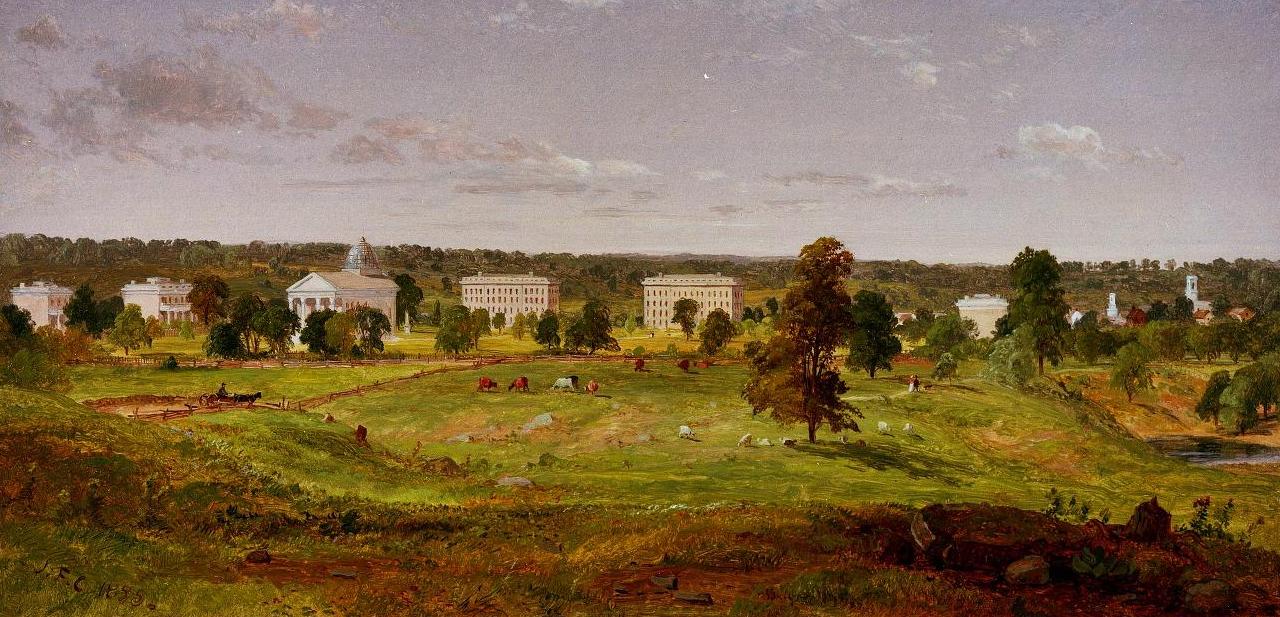|
Martha Cook Building
Martha Cook is a Collegiate Gothic women's residence hall at the University of Michigan in Ann Arbor. The building houses approximately 140 women pursuing undergraduate and graduate degrees from the University. Women may live in the building through all of their years of study, which is one of the features that separates this dormitory from other dormitory housing options. Martha Cook opened in the fall of 1915 as the first dormitory on campus for female students. Profile The residence is one of three all-female residence halls on campus. Originally built for approximately 110 young women, more than 140 first-year students to graduates now live in the building. Martha Cook has many unique traditions, including weekly teas on Fridays. These teas are open to residents and their guests, although all members of the public are invited to Martha Cook's International Tea which is held in early spring each year. Other traditions which residents enjoy include the Dinner for New Women, ... [...More Info...] [...Related Items...] OR: [Wikipedia] [Google] [Baidu] |
Collegiate Gothic
Collegiate Gothic is an architectural style subgenre of Gothic Revival architecture, popular in the late-19th and early-20th centuries for college and high school buildings in the United States and Canada, and to a certain extent Europe. A form of historicist architecture, it took its inspiration from English Tudor and Gothic buildings. It has returned in the 21st century in the form of prominent new buildings at schools and universities including Princeton and Yale. Ralph Adams Cram, arguably the leading Gothic Revival architect and theoretician in the early 20th century, wrote about the appeal of the Gothic for educational facilities in his book ''Gothic Quest:'' "Through architecture and its allied arts we have the power to bend men and sway them as few have who depended on the spoken word. It is for us, as part of our duty as our highest privilege to act...for spreading what is true." History Beginnings Gothic Revival architecture was used for American college bu ... [...More Info...] [...Related Items...] OR: [Wikipedia] [Google] [Baidu] |
Dormitory
A dormitory (originated from the Latin word ''dormitorium'', often abbreviated to dorm) is a building primarily providing sleeping and residential quarters for large numbers of people such as boarding school, high school, college or university students. In some countries, it can also refer to a room containing several beds accommodating people. Terminology Dorm and residence hall The terms "dorm" is often used in the US. However, within the residence life community, the official term "residence hall" is preferred. According to the University of Oregon, their facilities "provide not just a place to sleep, but also opportunities for personal and educational growth. Highly trained Residence Life staff and Hall Government officers support this objective by creating engaging activities and programs in each hall or complex." In the UK, the preferred term in the context of student housing is "halls," short for "halls of residence." In English-speaking Canada, the common term i ... [...More Info...] [...Related Items...] OR: [Wikipedia] [Google] [Baidu] |
University Of Michigan
, mottoeng = "Arts, Knowledge, Truth" , former_names = Catholepistemiad, or University of Michigania (1817–1821) , budget = $10.3 billion (2021) , endowment = $17 billion (2021)As of October 25, 2021. , president = Santa Ono , provost = Laurie McCauley , established = , type = Public research university , academic_affiliations = , students = 48,090 (2021) , undergrad = 31,329 (2021) , postgrad = 16,578 (2021) , administrative_staff = 18,986 (2014) , faculty = 6,771 (2014) , city = Ann Arbor , state = Michigan , country = United States , coor = , campus = Midsize City, Total: , including arboretum , colors = Maize & Blue , nickname = Wolverines , sp ... [...More Info...] [...Related Items...] OR: [Wikipedia] [Google] [Baidu] |
Ann Arbor, Michigan
Ann Arbor is a city in the U.S. state of Michigan and the county seat of Washtenaw County. The 2020 census recorded its population to be 123,851. It is the principal city of the Ann Arbor Metropolitan Statistical Area, which encompasses all of Washtenaw County. Ann Arbor is also included in the Greater Detroit Combined Statistical Area and the Great Lakes megalopolis, the most populated and largest megalopolis in North America. Ann Arbor is home to the University of Michigan. The university significantly shapes Ann Arbor's economy as it employs about 30,000 workers, including about 12,000 in the medical center. The city's economy is also centered on high technology, with several companies drawn to the area by the university's research and development infrastructure. Ann Arbor was founded in 1824, named after the wives of the village's founders, both named Ann, and the stands of bur oak trees.Marwil, pp. 1–2 The city's population grew at a rapid rate in the early ... [...More Info...] [...Related Items...] OR: [Wikipedia] [Google] [Baidu] |
Martha Cook Building Ann Arbor Michigan
Martha (Hebrew language, Hebrew: מָרְתָא) is a Bible, biblical figure described in the Gospels of Gospel of Luke, Luke and Gospel of John, John. Together with her siblings Lazarus of Bethany, Lazarus and Mary of Bethany, she is described as living in the village of Bethany near Jerusalem. She was witness to Jesus resurrecting her brother, Lazarus of Bethany, Lazarus. Etymology of the name The name ''Martha'' is a Latin transliteration of the Koine Greek Μάρθα, itself a translation of the Aramaic מָרְתָא ''Mârtâ,'' "the mistress" or "the lady", from מרה "mistress," feminine of מר "master." The Aramaic form occurs in a Nabatean inscription found at Puteoli, and now in the Naples Museum; it is dated AD 5 (Corpus Inscr. Semit., 158); also in a Tadmor, Syria, Palmyrene inscription, where the Greek translation has the form ''Marthein.'' Pope, Hugh"St. Martha" The Catholic Encyclopedia. Vol. 9. New York: Robert Appleton Company, 1919. Biblical reference ... [...More Info...] [...Related Items...] OR: [Wikipedia] [Google] [Baidu] |
York And Sawyer
York and Sawyer was an American architectural firm active between 1898 and 1949. The firms' work is exemplary of Beaux-Arts architecture as it was practiced in the United States. The partners Edward York (July 23, 1863– December 30, 1928) and Philip Sawyer (1868–1949) both trained in the office of McKim, Mead & White in the 1890s. In 1898, they established their independent firm, based in New York City. Their structure for the New-York Historical Society (1908) was extended in 1938 by Walker & Gillette. Their ability to organize, separate and coordinate mixed uses in a building is exemplified by their massive New York Athletic Club. York and Sawyer became known as specialists in the design of banks and hospitals. Original architectural drawings by York and Sawyer are held in the Dept. of Drawings & Archives at Avery Architectural and Fine Arts Library at Columbia University in New York City. Works All but three projects are located in the US, two in Canada (Montreal ... [...More Info...] [...Related Items...] OR: [Wikipedia] [Google] [Baidu] |
William W
William is a masculine given name of Norman French origin.Hanks, Hardcastle and Hodges, ''Oxford Dictionary of First Names'', Oxford University Press, 2nd edition, , p. 276. It became very popular in the English language after the Norman conquest of England in 1066,All Things William"Meaning & Origin of the Name"/ref> and remained so throughout the Middle Ages and into the modern era. It is sometimes abbreviated "Wm." Shortened familiar versions in English include Will, Wills, Willy, Willie, Liam, Bill, and Billy. A common Irish form is Liam. Scottish diminutives include Wull, Willie or Wullie (as in Oor Wullie or the play ''Douglas''). Female forms are Willa, Willemina, Wilma and Wilhelmina. Etymology William is related to the German given name ''Wilhelm''. Both ultimately descend from Proto-Germanic ''*Wiljahelmaz'', with a direct cognate also in the Old Norse name ''Vilhjalmr'' and a West Germanic borrowing into Medieval Latin ''Willelmus''. The Proto-Germa ... [...More Info...] [...Related Items...] OR: [Wikipedia] [Google] [Baidu] |
Furio Piccirilli
Furio Piccirilli (March 27, 1868 – January 17, 1949) was an Italian-born American sculptor and one of the Piccirilli Brothers. Piccirilli was born in Massa, Italy into a family with a long tradition of carving and sculpting. Like his older brother Attilio he was educated at the Accademia di San Luca of Rome. With his brother Attilio he immigrated to England in the mid-1880s and then moved to the United States in 1888. With their father and brothers he helped establish the Piccirilli Brothers carving business. He was a well known and respected sculptor aside from being known in connection with his family firm. He was "considered the most creative and the best modeler" of all the brothers. Piccirilli Brothers carved the architectural sculpture for the Parliament Building in Winnipeg, Manitoba. Furio modeled the four larger-than-life seated figures that flank the side entrances. Furio returned to Italy to get married in 1921, and then moved there permanently in 1926. He di ... [...More Info...] [...Related Items...] OR: [Wikipedia] [Google] [Baidu] |
Samuel Parsons
Samuel Bowne Parsons Jr. (8 February 1844 – 3 February 1923), was an American landscape architect. He is remembered as being a founder of the American Society of Landscape Architects, helping to establish the profession. Early years Parsons was born in New Bedford, Massachusetts in 1844 to Samuel Bowne Parsons Sr. (1819–1906) and Susan R. Howland (1824–1854). His father was the son of Samuel Parsons (1774–1841), who moved to Flushing from Manhattan around 1800 and married Mary Bowne (1784–1839). Samuel Bowne Parsons Sr. was an accomplished and well noted horticulturist, who was the first to import Japanese Maples and propagate rhododendrons. Samuel received his practical training and knowledge of landscaping and landscape materials working for J.R. Trumpy, the manager of his father’s nursery in Flushing, Queens. Parsons then went to school at Yale University and graduated with a Bachelor's degree in Philosophy in 1862, after which he spent several years studying a ... [...More Info...] [...Related Items...] OR: [Wikipedia] [Google] [Baidu] |
Portia
Portia may refer to: Biology * ''Portia'' (spider), a genus of jumping spiders *''Anaea troglodyta'' or Portia, a brush-footed butterfly *Portia tree, a plant native to Polynesia Medication A form of birth control made of ethinylestradiol/levonorgestrel Other uses *Portia (moon), a moon of Uranus *Portia Club, a women's club in Payette, Idaho/USA * Portia, Missouri, a community in the United States * PORTIA portfolio-management software from Thomson Financial * HMS ''Lennox'' (1914) or HMS ''Portia'', a ''Laforey''-class destroyer launched in 1914 People with the given name *Portia Arthur (born 1990), Ghanaian author, writer and reporter *Porcia Catonis, the wife of Roman senator Marcus Junius Brutus (fictionalized as a character in William Shakespeare's play ''Julius Caesar'' as "Portia") *Portia Dawson, American actress *Portia de Rossi or Portia DeGeneres, Australian-born actress *Portia Doubleday, American actress *Portia Geach (1873–1959), Australian artist and feminis ... [...More Info...] [...Related Items...] OR: [Wikipedia] [Google] [Baidu] |
University Of Michigan Campus
A university () is an institution of higher (or tertiary) education and research which awards academic degrees in several academic disciplines. ''University'' is derived from the Latin phrase ''universitas magistrorum et scholarium'', which roughly means "community of teachers and scholars". Universities typically offer both undergraduate and postgraduate programs. The first universities in Europe were established by Catholic Church monks. The University of Bologna (), Italy, which was founded in 1088, is the first university in the sense of: *being a high degree-awarding institute. *using the word ''universitas'' (which was coined at its foundation). *having independence from the ecclesiastic schools and issuing secular as well as non-secular degrees (with teaching conducted by both clergy and non-clergy): grammar, rhetoric, logic, theology, canon law, notarial law.Hunt Janin: "The university in medieval life, 1179–1499", McFarland, 2008, , p. 55f.de Ridder-Symoens, Hilde' ... [...More Info...] [...Related Items...] OR: [Wikipedia] [Google] [Baidu] |





.jpg)